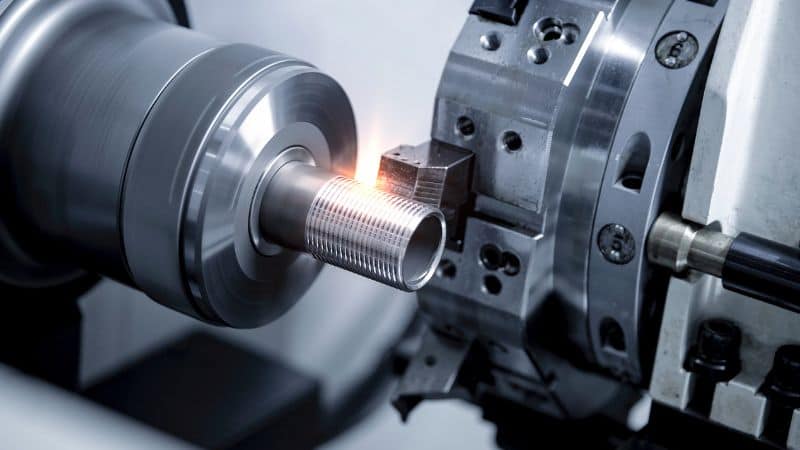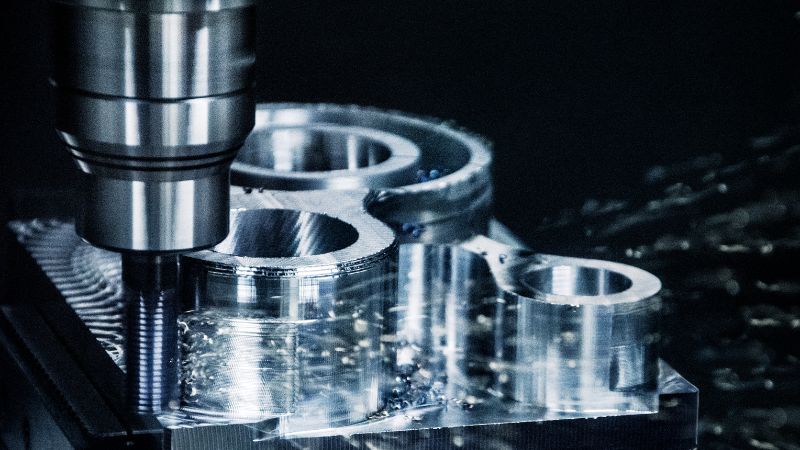Basics of CNC Turning
CNC turning is a subtractive manufacturing process that removes material from a rotating workpiece. Unlike manual lathes, CNC turning uses computer programming to control the cutting tools with extreme precision.
In this process, a piece of stock material is held in a chuck and spun at high speeds. While the material rotates, cutting tools move into the workpiece to shear away unwanted material.
The computer controls the exact position, speed, and path of these cutting tools. This allows for creating complex cylindrical shapes with tight tolerances.
Most CNC turning happens on machines called lathes. Modern CNC lathes can perform multiple operations in a single setup, including turning, boring, drilling, and threading.
Differences Between CNC Turning and Milling
CNC turning and milling are both subtractive manufacturing processes, but they operate differently. In turning, the workpiece rotates while cutting tools remain relatively stationary. In milling, the cutting tool rotates while the workpiece stays fixed.
Turning is ideal for creating cylindrical parts with symmetry around a central axis. Milling works better for flat surfaces, slots, and contoured features.
Turning typically produces parts faster than milling when working with cylindrical objects. However, milling offers more flexibility for complex geometric shapes that aren’t symmetrical.
A key difference is that turning can only cut material that’s accessible from the outside diameter, inside diameter, or face of the rotating part. Milling can access material from multiple angles.
Common Materials Used in CNC Turning
CNC turning works with a wide range of materials to meet different application needs:
Metals:
- Aluminum (easy to machine, lightweight)
- Steel (various grades for strength and durability)
- Stainless steel (corrosion resistance)
- Brass (good electrical conductivity)
- Titanium (strength-to-weight ratio)
Plastics:
- Delrin/Acetal (wear resistance)
- Nylon (toughness and flexibility)
- PEEK (high-temperature applications)
- Polycarbonate (impact resistance)
Material selection depends on your part’s requirements for strength, weight, cost, and environmental factors. Softer materials like aluminum and plastics generally machine faster and cause less tool wear than harder materials like stainless steel or titanium.
The hardness, ductility, and thermal properties of your chosen material will affect cutting speeds, tool selection, and cooling requirements during the turning process.
CNC Turning Operations

CNC turning machines perform many different operations to shape metal parts. Each operation uses specific tools and techniques to create features like threads, holes, and surface finishes.
Facing, Threading, and Boring
Facing creates a flat surface on the end of your workpiece. When you need a perfectly square end on your cylindrical part, the facing tool moves across the rotating material to remove a thin layer. This operation ensures parts fit together correctly in assemblies.
Threading cuts spiral grooves into your workpiece to create screws or threaded holes. You can make different thread types like metric, imperial, or custom designs. The threading tool moves at a precise feed rate while the workpiece rotates to create consistent threads.
Boring enlarges and finishes existing holes in your workpiece. This operation improves the accuracy of hole diameters and creates smooth internal surfaces. Boring tools reach inside cavities to remove material with high precision, often achieving tolerances of 0.001 inches or better.
Knurling and Drilling
Knurling creates raised patterns on your workpiece surface to improve grip. When you need a non-slip handle or thumbwheel, knurling tools press against the rotating material to form diamond or straight-line patterns. This process actually displaces material rather than removing it.
Drilling makes holes in your workpiece using rotating drill bits. CNC lathes can drill perfectly centered holes because the workpiece rotates while the stationary drill moves forward. You can create various hole sizes by changing drill bits.
The CNC machine automatically adjusts speeds and feeds based on material type and hole diameter. For better results, the machine often uses peck drilling—a technique where the drill periodically retracts to clear chips and prevent overheating.
Parting and Grooving
Parting cuts off completed sections of your workpiece. The parting tool moves inward toward the center axis while the material rotates, creating a narrow channel until the piece separates. This operation often completes a turning job by removing the finished part.
Grooving creates channels, recesses, or slots in your workpiece. You might need grooves for O-rings, retaining rings, or decorative features. Grooving tools come in different widths and shapes to match your specific requirements.
Both operations require careful attention to cutting speed and cooling. Too much heat can damage tools and parts.
Your CNC program will typically slow down the rotation speed and increase coolant flow during these operations to maintain quality and extend tool life.
CNC Turning Machines

CNC turning machines, also known as CNC lathes, are specialized equipment that performs the turning process with computer control. These machines hold and rotate workpieces while cutting tools remove material to create the desired shape.
Types of CNC Lathes
Horizontal Lathes are the most common type. They hold the workpiece horizontally, making them ideal for long, cylindrical parts. You’ll find these in many machine shops handling everyday turning jobs.
Vertical Lathes position the workpiece vertically. You might choose these for large, heavy parts that would be difficult to support horizontally. They’re excellent for parts with large diameters.
Swiss-Type Lathes are designed for small, precise components. You’ll appreciate their ability to machine tiny parts with extreme accuracy, making them perfect for medical devices and watch components.
Multi-Axis Lathes offer movement in 4 or 5 axes. These give you the ability to create complex geometries in a single setup, reducing handling time and improving accuracy.
Key Features of CNC Turning Centers
Turret Systems hold multiple cutting tools that can be quickly rotated into position. You can program tool changes to happen automatically, saving time between operations.
Live Tooling allows rotating tools like drills and mills to work on the piece while it’s mounted. This feature helps you complete complex parts without transferring to another machine.
Part Catchers collect finished pieces as they’re cut off. Your production efficiency improves since the machine can run continuously without operator intervention.
Control Systems vary in complexity and capability. Modern controls offer intuitive interfaces, simulation capabilities, and network connectivity so you can monitor production remotely.
Automatic Bar Feeders supply new material as needed. This automation lets you run the machine for extended periods, even unattended overnight in some cases.
Programming for CNC Turning
Programming is the heart of CNC turning operations. It tells the machine exactly how to move to create your part and controls everything from cutting speed to tool selection.
Understanding G-Code
G-code is the language that CNC turning machines understand. It’s a set of instructions that tell the machine what to do and how to move. Each line of code represents a specific action or movement.
Common G-codes for turning include:
- G00: Rapid positioning
- G01: Linear interpolation (straight line cutting)
- G02/G03: Circular interpolation (creating arcs)
- G70: Finishing cycle
- G71: Rough turning cycle
- G73: Pattern repeating cycle
When you write G-code, you’re essentially creating a step-by-step guide for the machine. Each command includes coordinates that tell the tool where to move.
You don’t need to memorize all G-codes. Modern machines have helpful interfaces that make programming easier.
CAM Software in CNC Turning
Computer-Aided Manufacturing (CAM) software has revolutionized CNC turning programming. Instead of writing G-code manually, you can use CAM software to generate it automatically.
The process works like this:
- Import your 3D model into the CAM software
- Select the operations you want to perform
- Choose tools and cutting parameters
- The software generates the G-code for you
Popular CAM software for turning includes Mastercam, Fusion 360, and ESPRIT. These programs simulate the cutting process before you send the code to your machine.
This simulation is crucial. It lets you spot potential problems before actual cutting begins, saving time and materials. You can see exactly how the tool will move and make adjustments as needed.
Applications of CNC Turning
CNC turning creates precise cylindrical components for many industries. The process excels at making parts that require high accuracy and consistent quality for critical applications.
Aerospace and Automotive Parts
In aerospace, CNC turning produces engine components, shafts, and fasteners that must meet strict safety standards. These parts need perfect balance and precision to handle extreme conditions. You’ll find CNC-turned components in jet engines, landing gear, and control systems.
For automotive manufacturing, CNC turning creates essential parts like drive shafts, pistons, and brake components. The process ensures these parts have the exact dimensions needed for proper vehicle operation.
Benefits for these industries include:
- Consistency across thousands of identical parts
- Durability through precise material selection
- Weight reduction by removing unnecessary material
Car manufacturers rely on CNC turning for both prototype development and mass production parts that require tight tolerances.
Medical Devices and Equipment
CNC turning is crucial for creating medical devices where precision can be life-saving. You’ll find CNC-turned components in surgical instruments, implants, and diagnostic equipment.
Common medical applications include:
- Bone screws and dental implants
- Components for MRI and CT scanning equipment
- Surgical tools with complex features
- Precision parts for medical pumps and monitors
The biocompatible materials used in medical CNC turning, such as titanium and medical-grade stainless steel, ensure parts are safe for use in the human body.
CNC turning allows for consistent quality control in medical manufacturing, where even tiny variations could affect patient outcomes. The precision of modern CNC turning machines makes them ideal for creating the smooth, polished surfaces needed for implantable devices.
Quality Control in CNC Turning
Quality control is essential in CNC turning to ensure parts meet specifications and function as intended. Proper quality measures help prevent costly errors and ensure customer satisfaction.
Tolerances and Surface Finish
In CNC turning, tolerances refer to the acceptable variation in dimensions of the finished part. Typical turning tolerances range from ±0.005″ for standard work to ±0.0005″ for precision applications.
Surface finish is measured in Ra (roughness average) values. The lower the Ra value, the smoother the surface. CNC turning can achieve finishes from 32 Ra for rough cuts to 8 Ra or better for finish passes.
Your specifications should clearly state required tolerances and surface finishes. This ensures the machinist programs the CNC lathe correctly for your needs.
Modern CNC turning centers can maintain tight tolerances throughout production runs. This consistency is a key advantage over manual turning methods.
Inspection and Quality Assurance Methods
Your turned parts will undergo various inspection methods to verify quality. Common tools include:
- Micrometers and calipers for dimensional checks
- Surface roughness testers for finish verification
- Coordinate Measuring Machines (CMMs) for complex geometry validation
First article inspection is standard practice where the first part is thoroughly checked before full production begins. This catches potential issues early.
Statistical Process Control (SPC) helps monitor ongoing production quality. Measurements from sample parts are tracked to spot trends before they become problems.
Machine tool probing systems can perform in-process measurements during machining. This automates quality checks and allows for real-time adjustments.
Your quality requirements should be clearly communicated to the machine shop to ensure they apply appropriate inspection methods.
